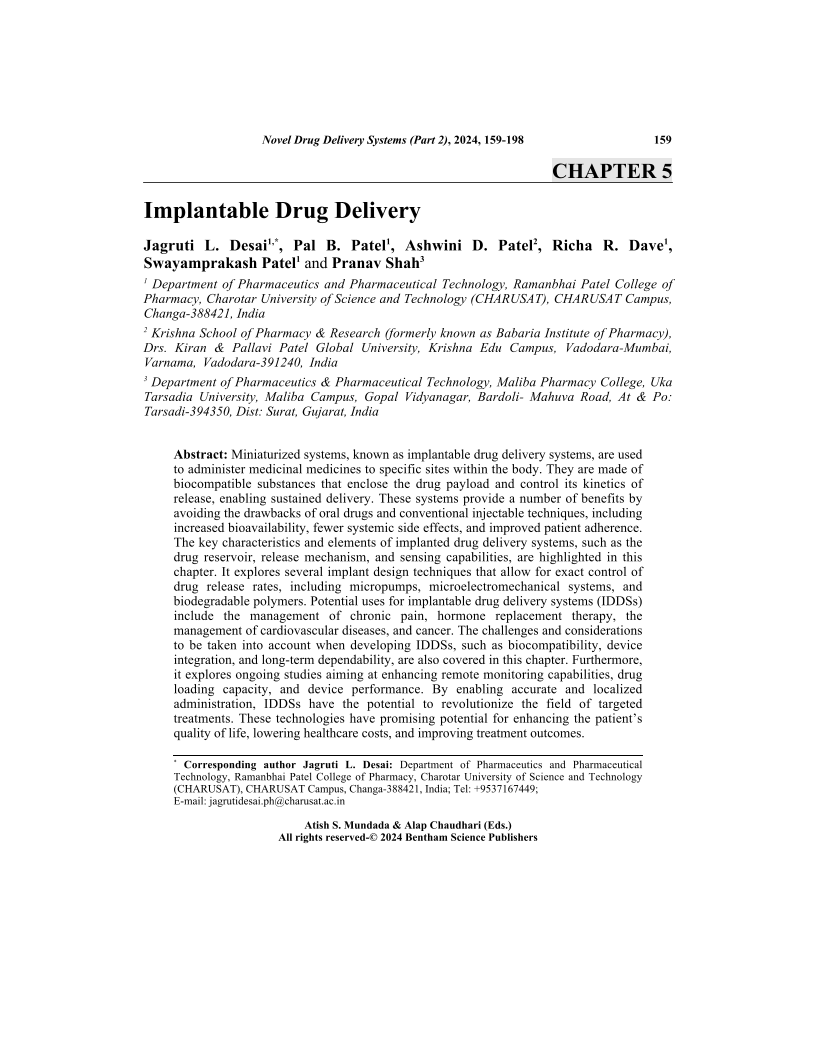Implantable Drug Delivery

- Authors: Jagruti L. Desai1, Pal B. Patel2, Ashwini D. Patel3, Richa R. Dave4, Swayamprakash Patel5, Pranav Shah6
-
View Affiliations Hide Affiliations1 Department of Pharmaceutics and Pharmaceutical Technology, Ramanbhai Patel College of Pharmacy, Charotar University of Science and Technology (CHARUSAT), CHARUSAT Campus, Changa 388421, India 2 Department of Pharmaceutics and Pharmaceutical Technology, Ramanbhai Patel College of Pharmacy, Charotar University of Science and Technology (CHARUSAT), CHARUSAT Campus, Changa-388421, India 3 Krishna School of Pharmacy & Research (formerly known as Babaria Institute of Pharmacy), Drs. Kiran & Pallavi Patel Global University, Krishna Edu Campus, Vadodara-Mumbai, Varnama, Vadodara-391240, India 4 Department of Pharmaceutics and Pharmaceutical Technology, Ramanbhai Patel College of Pharmacy, Charotar University of Science and Technology (CHARUSAT), CHARUSAT Campus, Changa-388421, India 5 Department of Pharmaceutics and Pharmaceutical Technology, Ramanbhai Patel College of Pharmacy, Charotar University of Science and Technology (CHARUSAT), CHARUSAT Campus, Changa-388421, India 6 Department of Pharmaceutics & Pharmaceutical Technology, Maliba Pharmacy College, Uka Tarsadia University, Maliba Campus, Gopal Vidyanagar, Bardoli- Mahuva Road, At & Po: Tarsadi-394350, Dist: Surat, Gujarat, India
- Source: Novel Drug Delivery Systems (Part 2) , pp 159-198
- Publication Date: December 2024
- Language: English
Implantable Drug Delivery, Page 1 of 1
< Previous page | Next page > /docserver/preview/fulltext/9789815313567/chapter-5-1.gif
Miniaturized systems, known as implantable drug delivery systems, are used to administer medicinal medicines to specific sites within the body. They are made of biocompatible substances that enclose the drug payload and control its kinetics of release, enabling sustained delivery. These systems provide a number of benefits by avoiding the drawbacks of oral drugs and conventional injectable techniques, including increased bioavailability, fewer systemic side effects, and improved patient adherence. The key characteristics and elements of implanted drug delivery systems, such as the drug reservoir, release mechanism, and sensing capabilities, are highlighted in this chapter. It explores several implant design techniques that allow for exact control of drug release rates, including micropumps, microelectromechanical systems, and biodegradable polymers. Potential uses for implantable drug delivery systems (IDDSs) include the management of chronic pain, hormone replacement therapy, the management of cardiovascular diseases, and cancer. The challenges and considerations to be taken into account when developing IDDSs, such as biocompatibility, device integration, and long-term dependability, are also covered in this chapter. Furthermore, it explores ongoing studies aiming at enhancing remote monitoring capabilities, drug loading capacity, and device performance. By enabling accurate and localized administration, IDDSs have the potential to revolutionize the field of targeted treatments. These technologies have promising potential for enhancing the patient's quality of life, lowering healthcare costs, and improving treatment outcomes.
-
From This Site
/content/books/9789815313567.chapter-5dcterms_subject,pub_keyword-contentType:Journal -contentType:Figure -contentType:Table -contentType:SupplementaryData105

